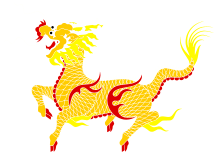 | |
| Grouping | Legendary creature |
|---|---|
| Sub grouping | Chimera |
| Similar entities | kirin, kỳ lân, gilen |
| First attested | 5th century BCE |
| Country | China |
| Qilin | |||||||||||||||||||||||
|---|---|---|---|---|---|---|---|---|---|---|---|---|---|---|---|---|---|---|---|---|---|---|---|
 "Qilin" in Chinese characters "Qilin" in Chinese characters | |||||||||||||||||||||||
| Chinese name | |||||||||||||||||||||||
| Chinese | 麒麟 | ||||||||||||||||||||||
| |||||||||||||||||||||||
| Vietnamese name | |||||||||||||||||||||||
| Vietnamese alphabet | kỳ lân | ||||||||||||||||||||||
| Chữ Hán | 麒麟 | ||||||||||||||||||||||
| Thai name | |||||||||||||||||||||||
| Thai | กิเลน | ||||||||||||||||||||||
| RTGS | kilen | ||||||||||||||||||||||
| Korean name | |||||||||||||||||||||||
| Hangul | 기린 | ||||||||||||||||||||||
| Hanja | 麒麟 | ||||||||||||||||||||||
| |||||||||||||||||||||||
| Japanese name | |||||||||||||||||||||||
| Kanji | 麒麟 | ||||||||||||||||||||||
| Hiragana | きりん | ||||||||||||||||||||||
| |||||||||||||||||||||||
| Manchu name | |||||||||||||||||||||||
| Manchu script | ᡴᡳᠯᡳᠨ | ||||||||||||||||||||||
| Romanization | kilin | ||||||||||||||||||||||
The qilin (English: /tʃiˈlɪn/ chee-LIN; Chinese: 麒麟) is a legendary hooved chimerical creature that appears in Chinese mythology, and is said to appear with the imminent arrival or death of a sage or illustrious ruler. Qilin are a specific type of the lin mythological family of one-horned beasts. The qilin also appears in the mythologies of other Chinese-influenced cultures.
Origins

The earliest mention of the mythical qilin is in the poem 麟之趾; Lín zhī zhǐ; 'Feet of the Lin' included in the Classic of Poetry (11th – 7th c. BCE). Spring and Autumn Annals mentioned that a lin (麟) was captured in the 14th year of Duke Ai of Lu (魯哀公) (481 CE); Zuo Zhuan credited Confucius with identifying the lin as such.
The bisyllabic form qilin (麒麟 ~ 騏驎), which carries the same generic meaning as lin alone, is attested in works dated to the Warring States period (475–221 BCE). Qi denotes the male and lin denotes the female according to Shuowen Jiezi.
The legendary image of the qilin became associated with the image of the giraffe in the Ming dynasty. The identification of the qilin with giraffes began after Zheng He's 15th-century voyage to East Africa (landing, among other places, in modern-day Somalia). The Ming Dynasty bought giraffes from the Somali merchants along with zebras, incense, and various other exotic animals. Zheng He's fleet brought back two giraffes to Nanjing and they were mistaken by the emperor for the mythical creature, with geri meaning giraffe in Somali. The identification of qilin with giraffes has had a lasting influence: even today, the same word is used for the mythical animal and the giraffe in both Korean and Japanese.

Axel Schuessler reconstructs Old Chinese pronunciation of 麒麟 as *gərin. Finnish linguist Juha Janhunen tentatively compares *gərin to an etymon reconstructed as *kalimV, denoting "whale"; and represented in the language isolate Nivkh and four different language families Tungusic, Mongolic, Turkic and Samoyedic, wherein *kalay(ә)ng means "whale" (in Nenets) and *kalVyǝ "mammoth" (in Enets and Nganasan). As even aborigines "vaguely familiar with the underlying real animals" often confuse the whale, mammoth, and unicorn: they conceptualized the mammoth and whale as aquatic, as well as the mammoth and unicorn possessing a single horn; for inland populations, the extant whale "remains ... an abstraction, in this respect being no different from the extinct mammoth or the truly mythical unicorn." However, Janhunen cautiously remarks that "he formal and semantic similarity between *kilin < *gilin ~ *gïlin 'unicorn' and *kalimV 'whale' (but also Samoyedic *kalay- 'mammoth') is sufficient to support, though perhaps not confirm, the hypothesis of an etymological connection", and also notes a possible connection between Old Chinese and Mongolian (*)kers ~ (*)keris ~ (*)kiris "rhinoceros" (Khalkha: хирс).
Description

Qilin generally have Chinese dragon-like features: similar heads with antlers, eyes with thick eyelashes, manes that always flow upward, and beards. The body is fully or partially scaled and often shaped like an ox, deer, or horse, or more commonly a goat. They are always shown with cloven hooves. While dragons in China (and thus qilin) are also most commonly depicted as golden, qilin may be of any color or even various colors, and can be depicted as bejeweled or exhibiting a jewel-like brilliance.
The qilin is depicted throughout a wide range of Chinese art, sometimes with parts of their bodies on fire.
Legends tell that qilin have appeared in the garden of the legendary Yellow Emperor and in the capital of Emperor Yao; both events bore testimony to the benevolent nature of the rulers. It has also been told that the birth of the great sage Confucius was foretold by the arrival of a qilin.
Qilin as unicorns

In modern times, the depictions of qilin have often fused with the Western concept of unicorns, and qilin (麒麟) is often translated into English as "unicorn". The Han dynasty dictionary Shuowen Jiezi describes qi as single-horned, and it can sometimes be depicted as having a single horn. The translation, however, may be misleading, as qilin can also be depicted as having two horns. In modern Chinese, "one-horned beast" (独角兽; 獨角獸; Dújiǎoshòu) is used for "unicorns". A number of different Chinese mythical creatures can be depicted with a single horn, and a qilin depicted with one horn may be called a "one-horned qilin" in Chinese.
Nevertheless, the mythical and etymological connections between the creatures have been noted by various cultural studies and even the Chinese government, which has minted silver, gold, and platinum commemorative coins depicting both archetypal creatures.
Other cultural representations

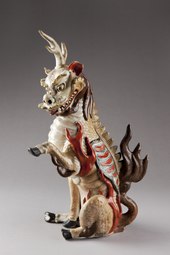
East Asia
Japan
Kirin, which has also come to be used as the modern Japanese word for a giraffe, are similar to qilin. Japanese art tends to depict the kirin as more deer-like than in Chinese art. Alternatively, it is depicted as a dragon shaped like a deer, but with an ox's tail instead of a lion's tail. They are also often portrayed as partially unicorn-like in appearance, but with a backwards curving horn.
Korea
Girin or kirin (기린) is the Korean form of qilin. It is described as a maned creature with the torso of a deer, an ox tail with the hooves of a horse. The girin were initially depicted as more deer-like, however over time they have transformed into more horse-like. They were one of the four divine creatures along with the dragon, phoenix, and turtle. Girin were extensively used in Korean royal and Buddhist arts.
In modern Korean, the term "girin" is used for "giraffe".
Southeast Asia
Thailand
In Thailand, the qilin is known as "gilen" (Thai: กิเลน), and is a member of the pantheon of Thai Himapant forest mythical animals. It is most probable that the Gilen was introduced into the pantheon under the influence of the Tai Yai who came down from Southern China to settle in Siam in ancient times, and the legend was probably incorporated into the Himapant legends of Siam in this manner. The Gilen is a mixture of various animals, which come from differing elemental environments, representing elemental magical forces present within each personified creature. Many of the Himapant animals actually represent gods and devas of the Celestial Realms, and bodhisattvas, who manifest as personifications which represent the true nature of each creature deity through the symbolism of the various body parts amalgamated into the design of the Mythical creature.
In Phra Aphai Mani, the masterpiece epic poem of Sunthorn Phu, a renowned poet of the 18th century. There is a monster that is Sudsakorn's steed, one of the main characters in the epic. This creature was called "Ma Nin Mangkorn" (Thai: ม้านิลมังกร, "ceylonite dragon horse"), it is depicted as it has diamond fangs, ceylonite scales, and a birthmark on the tongue. It was a mixture of horse, dragon, deer antlers, fish scales, and Phaya Nak tail, with has black sequins all over. Its appearance resembles a qilin.
Gallery
-
 Qilin statue in Pingzhen Xinshi Park, Taoyuan, Taiwan
Qilin statue in Pingzhen Xinshi Park, Taoyuan, Taiwan
-
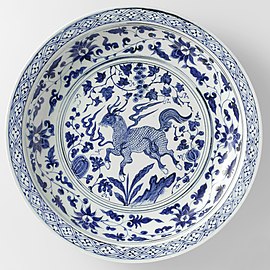 Plate with a qilin in the center, Yuan dynasty
Plate with a qilin in the center, Yuan dynasty
-
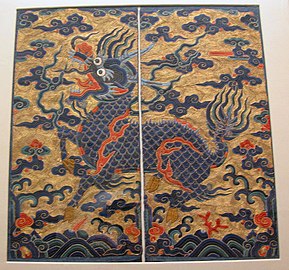 Embroidered qilin, Qing dynasty
Embroidered qilin, Qing dynasty
-
Kỳ Lân statues, Bat Trang kiln, Hanoi, Nguyen dynasty, crackle glaze ceramics – at the National Museum of Vietnamese History in Hanoi, Vietnam
- [REDACTED] The logo of Kirin Beer features a kirin (photo taken in Hiroshima, Japan)
-
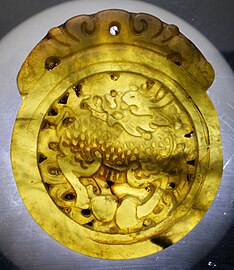 Qilin pendant
Qilin pendant
-
 An illustration of Simurgh and Qilin in Gulistan
An illustration of Simurgh and Qilin in Gulistan
-
Qilin incense burner (one of a pair) at the World Museum in Liverpool, United Kingdom
-
 Qilin depicted in the Imperial Encyclopaedia
Qilin depicted in the Imperial Encyclopaedia
-
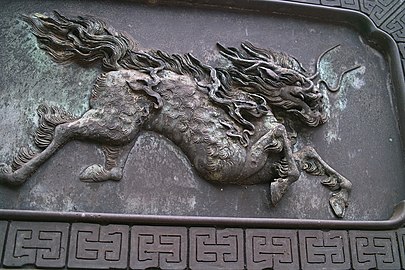 Kirin relief in Tokyo, Japan
Kirin relief in Tokyo, Japan
-
 A winged variant of kirin statue in Tokyo, Japan
A winged variant of kirin statue in Tokyo, Japan
-
 Qilin (kî-lîn) as an object of worship in Yilan, Taiwan
Qilin (kî-lîn) as an object of worship in Yilan, Taiwan
-
A Qing dynasty qilin-shaped incense burner
-
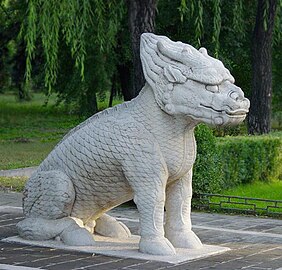 A qilin in the dragon, fish, and ox style of the Ming dynasty. Note the pair of horns.
A qilin in the dragon, fish, and ox style of the Ming dynasty. Note the pair of horns.
See also
- Chinese spiritual world concepts
- Chinthe
- Four Holy Beasts
- Kanglasha
- Longma
- Nian
- Nongshaba
- Pakhangba
- Pixiu
- Poubi Lai
- Questing Beast
- Serpopard
- Shaanxi Kylins
- Shisa
- Singha
- Sin-you
- Taoroinai
- Xiezhi
- Yali
References
- ^ "qilin (Chinese mythology)". Encyclopædia Britannica. Retrieved 24 July 2011.
- Classic of Poetry "Airs of Zhou and the South – Lin's Feet" translated by James Legge
- Durrant, Li, & Schaberg (translators) (2016). Zuo tradition: Commentary on the Spring and Autumn Annals. Seattle & London: University of Washington Press. p. 1920, n. 292. quote: "It is significant that the earliest source known to mention the lin itself is “Lin zhi zhi” 麟之趾, or “The Foot of the Lin"
- 古建上的主要装饰纹样――麒麟 古建园林技术-作者:徐华铛 Archived 30 September 2007 at the Wayback Machine
- Zuozhuan "Duke Ai – 14th year – jing & zhuan"'
- Durrant, Li, & Schaberg (translators) (2016). Zuo tradition: Commentary on the Spring and Autumn Annals. pp. 1919–1921
- ChinaKnowledge.de
- ^ SWJZ Radical 鹿" quote: "麟:大牝鹿也。……麒:仁獸也。麋身牛尾,一角。……麐:牝麒也。" translation: "Lín (麟): a large female deer. Qí (麒): a humane beast. With elaphure's body, ox's tail, and one horn. Lín (麐): female qí."
- Parker, Jeannie Thomas (2018) The Mythic Chinese unicorn. Victoria: Friesen Press. p. 44
- 此“麟”非彼“麟”专家称萨摩麟并非传说中麒麟
- "What Kind of Animal Was the Questing Beast?". Arthuriana. 14 (2): 66–69. 2004. ISSN 1078-6279. JSTOR 27870605.
- Wilson, Samuel M. (December 1992). "The Emperor's Giraffe". Natural History. Vol. 101, no. 12. pp. 22–25. Archived from the original on 2 December 2008. Retrieved 14 April 2012.
- ^ Parker, J. T.: "The Mythic Chinese Unicorn"
- ^ Janhunen, J. (2011). "Unicorn, Mammoth, Whale: mythological and etymological connections of zoonyms in North and East Asia". Linguistics, Archaeology and the Human Past, Occasional Paper, 12, 189–222.
- ^ "Хирс in Bolor dictionary". Archived from the original on 26 September 2022. Retrieved 31 January 2019.
- "Charger with a qilin, anonymous, c. 1350". Rijksmuseum. Retrieved 15 May 2022.
- ^ Liscomb, Kathyln (2016). "9: How the Giraffe Became a Qilin: Intercultural Signification in Ming Dynasty Arts". The Zoomorphic Imagination in Chinese Art and Culture. University of Hawai'i Press. pp. 341–378. ISBN 9780824872564.
- ^ Bush, Susan (2016). "2: Labeling the Creatures: Some Problems in Han and Six Dynasties Iconography". The Zoomorphic Imagination in Chinese Art and Culture. University of Hawai'i Press. pp. 76–77. ISBN 9780824872564.
- Yoshida, Masako (2014). "Trade Stories: Chinese Export Embroideries in the Metropolitan Museum". Metropolitan Museum Journal. 49 (1): 4–5. doi:10.1086/680031. JSTOR 10.1086/680031. S2CID 192217718.
- "5 Yuan, China". en.numista.com. Numista. Retrieved 13 December 2017.
- Griffis, William Elliot (2007). The Religions of Japan. Bibliobazaar. p. 39. ISBN 978-1-4264-9918-0.
- 기린 : 네이버캐스트
- "Taep Payatorn Riding Qilin Himapant Lion Hlang Yant – Nuea Pong Maha Sanaeh Luan – Ajarn Warut – Wat Pong Wonaram". Buddha Magic Multimedia & Publications. Retrieved 12 January 2016.
- Pralongchoeng, Gilen (20 September 2014). "ม้ามังกร" [Dragon horse]. Thai Rath (in Thai). Retrieved 7 August 2021.
External links
- [REDACTED] Media related to Qilin at Wikimedia Commons
| Chinese mythology | |
|---|---|
| Overview topics | |
| Major personages | |
| Mythological creatures | |
| Places | |
| Items | |
| Literary works |
|
| Other folk tales | |